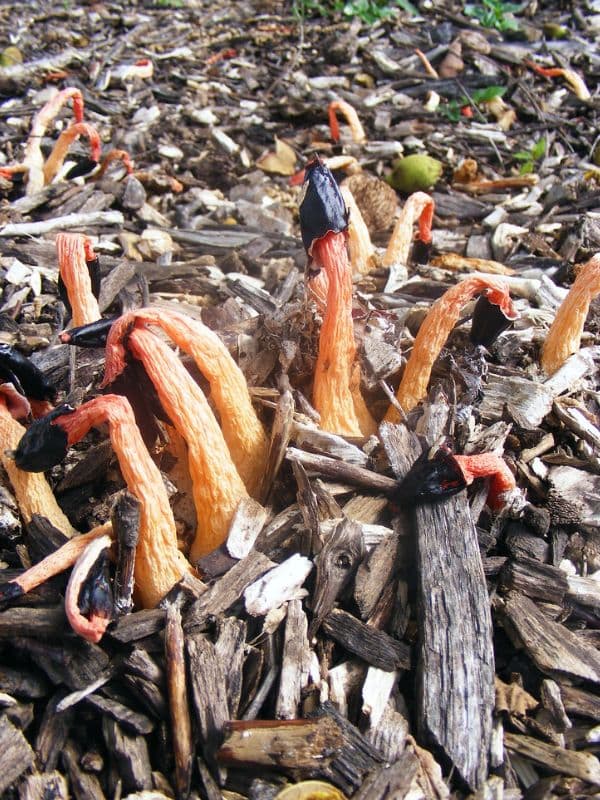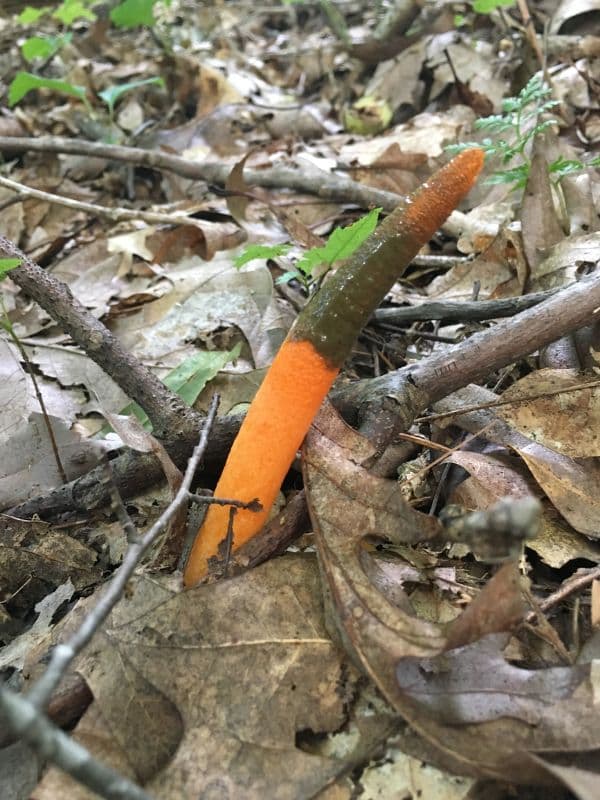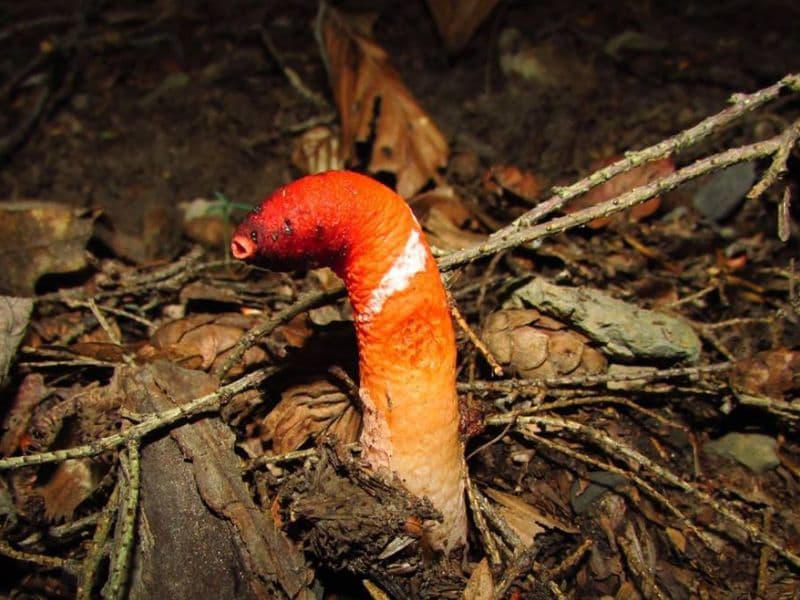Mutinus elegans, commonly known as Demon Fingers, Devil’s Dipstick, Dog Stinkhorn, Elegant Stinkhorn, or Headless Stinkhorn, is an intriguing member of the Phallaceae family. This unique mushroom species thrives in moist but well-drained environments, captivating gardeners and foragers alike with its unusual appearance and fascinating characteristics.
If you’ve ever been curious about this mushroom—whether it’s edible, how to identify it, or even how to grow it—this guide has you covered. From understanding its growth habits to harvesting and cultivation tips, you’ll discover why Mutinus elegans has become a favorite among mushroom enthusiasts.
| Common name | Demon Fingers, Devil’s Dipstick, Dog Stinkhorn, Elegant Stinkhorn, Headless Stinkhorn |
| Botanical name | Mutinus elegans |
| Family | Phallaceae |
| Species | elegans |
| Plant type | Mushroom |
| Drainage | Moist but Well-Drained |
| Growth rate | Fast |
| Harvest time | Summer |
| Height | 4 in. – 7 in. |
| Fruit color | Orange |
I. Appearance and Characteristics
Mutinus elegans, commonly known as the elegant stinkhorn, the dog stinkhorn, the headless stinkhorn, or the devil’s dipstick, is a species of fungus in the Phallaceae (stinkhorn) family.
Mutinus elegans was first described by British missionary John Banister in 1679 who chronicled the natural history of Virginia; this early report is thought to be the first account of a fungus in North America. It was first characterized scientifically by French scientist Jean Pierre François Camille Montagne in 1856, who called it Corynites elegans.
The genus name Mutinus refers to the Roman phallic deity Mutunus Tutunus, one of the di indigetes placated by Roman brides. The species is commonly known variously as the “elegant stinkhorn”, the “headless stinkhorn”, the “dog stinkhorn”, or the “devil’s dipstick”. The specific epithet elegans is derived from the Latin word meaning “graceful” or “elegant”.
The young fruiting bodies are initially white and spherical or egg-shaped, partially submerged in the ground, with dimensions of 2 to 3 cm (3⁄4 to 1+1⁄4 in) by 1 to 2 cm (1⁄2 to 3⁄4 in). As the fruit body matures, the egg ruptures and the spongy spore-bearing stalk emerges; fully grown, it may be from 1 to 15 cm (1⁄2 to 6 in) long and 1.5 to 2 cm (1⁄2 to 3⁄4 in) thick.

The stalk is hollow and strongly wrinkled overall; its shape is cylindrical below, but it gradually tapers to a narrow apex with a small opening at the tip. The upper half of the stalk is bright red to reddish orange, and the color gradually loses intensity transforming into pinkish white below.
The stalk may be straight, or slightly curved. A gelatinous greenish-brown gleba covers the upper third of the stalk in newly emerged specimens. The remains of the “egg” forms a volva around the base of the stalk. The odor of the gleba is foul; one author describes it as “sickly sweet or metallic”. The spores are a greenish-brown color. Fruit bodies are attached to the substrate by whitish rhizomorphs that resemble plant roots. American mycologist Alexander H. Smith noted that the eggs are often slow to open, sometimes taking up to two weeks before the stalk expands.
The spores are 4–7 by 2–3 µm, oblong-elliptical, smooth, and embedded in the gleba. A 1982 study revealed that spores of species in the family Phallaceae, including Mutinus elegans, have a hilum scar (0.2–0.3 µm diameter) that is observable with scanning electron microscopy. The hilar scar is a circular indentation at one end of the spore, and it most likely results during the separation of the attachment of the spore to the sterigma of the basidium.

Mutinus elegans is saprobic—deriving nutrients by breaking down dead or dying organic matter. It is commonly found in gardens and farm areas enriched with manure, near well-decayed stumps and logs, and in wood chips. A Japanese publication mentioned its occurrence in Takatsuki and Osaka-fu, where it fruited in November and December on the ground along paths or in open spaces, under or near bamboo (Phyllostachys bambusoides) and hardwoods such as the sawtooth oak, the Japanese Zelkova, and the Camphor tree.
This common species has been collected in eastern North America, in the area extending from Quebec to Florida and west to the Great Lakes, Iowa, Colorado, and Texas. In Europe, it has been reported from Netherlands and in Asia, it has been collected in Japan.
II. How to Grow and Care
Growing Mutinus elegans can be a rewarding experience for fungus enthusiasts. Proper soil preparation, planting, and maintenance are vital to achieving results. When preparing your soil, a compost-rich mix will provide it with its preferred environment. Consider adding limestone to get an ideal pH balance between 6-7 for these particular fungi to thrive.

When you are ready to plant, use small burlap or paper bags filled with the soil mix and place them shallowly into the ground. You’ll also want to ensure your plants have adequate shade and moisture throughout their growing season to maintain healthy growth.
Finally, limit disturbances to your garden bed since Mutinus elegans is particularly sensitive; weed carefully and avoid fertilizing or tilling the area.
III. Uses and Benefits
Mutinus elegans is an edible fungus with a distinctive look, texture, and flavor. It may appear unattractive to some, but this unique mushroom offers a variety of health benefits when consumed. Research has found that Mutinus elegans can help support a healthy immune system and reduce inflammation.
If you’re in the mood for a culinary adventure, preparing Mutinus elegans with just a few simple ingredients is easy. From creamy risotto to delicious stir-fries and spiced stews – Mutinus elegans is an easy ingredient that adds a touch of complexity and fun to any meal!
Eating this mushroom raw is not recommended; however, with its earthy taste, crunchy texture, and versatility when cooked – this mushroom can be added to your favourite recipes for an added flavor boost!

IV. Harvesting and Storage
Harvesting
About harvesting Mutinus elegans, knowing the proper techniques to ensure a safe collection is essential. The first step involves appropriate identification: a trained collector should be able to identify many different species of mushrooms and distinguish between edible types and dangerous species.
Secondly, when collecting, park a safe distance away from the mushroom patch and utilize a mesh bag or basket for collection.
Wear gloves when harvesting mushrooms, as this prevents physical contact with an unknown species and transfers smells or spores from one mushroom patch to another. Once they have been harvested, use caution while cleaning them since any cuts or tears in the mushroom can reduce its shelf life.
Lastly, always keep your finds in check and never consume wild mushrooms without knowing what they are!

Storage
When it comes to harvesting Mutinus Elegans, proper storage is critical in keeping them fresh and from deteriorating. Properly storing the mushrooms will allow you to enjoy their flavor for many weeks. The optimal method for storing Mutinus Elegans is by layering them with a damp paper towel and then enclosed in a sealed plastic container. The moisture the paper towel adds will help keep the mushrooms hydrated and prevent excess dehydration.
To further extend the lifespan of your harvested mushrooms, store them in a refrigerator at a temperature of between 35-45 degrees Fahrenheit.
If you want to store Mutinus Elegans mushrooms long-term, they can also be dried and stored in an airtight container in a cool, dark place indefinitely.








Leave a Reply